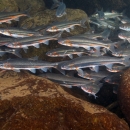The introduction and spread of non-native aquatic species can have profound consequences for aquatic habitats and species. From hybridization between trout species to ecosystem-level changes caused by zebra and quagga mussels, addressing threats and impacts from non-native species are a challenge to natural resource managers. In many cases, it is impossible to completely remove a non-native species from a lake or river once it is well established. Population control may be possible in some settings, and program staff have used modeling, technological, and ecological field studies to investigate the decision space. Most recently, we have been focusing on common carp and brook trout. We recently completed a large field experiment to understand the relationship between biomass of carp and water quality and the presence and abundance of submerged aquatic vegetation that is of interest to biologists seeking to reduce carp populations and provide better habitat for resident and migratory birds. We have also partnered with the Columbia River Fish and Wildlife Conservation Office and Carson National Fish Hatchery to evaluate the use of Trojan (YY male) brook trout to eradicate a nonnative brook trout population that occupies the hatchery's primary water source.
Research

